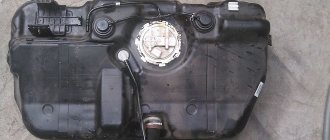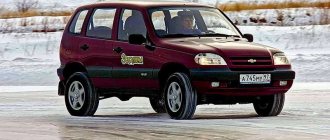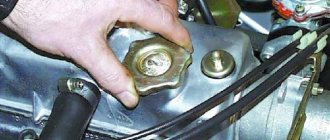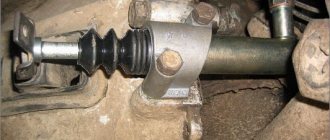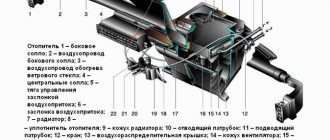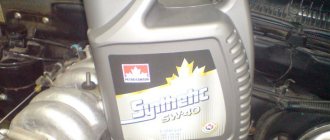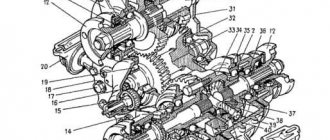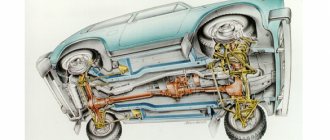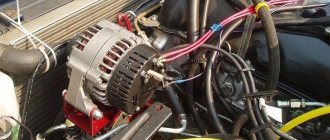Practical experience and common sense indicate that the following tanks are most common:
- 40.
- 50.
- 60.
- 70 liters.
Based on these parameters, you can judge the dimensions and approximate characteristics of the vehicle. There is no point in equipping a subcompact VW Beetle with large “reservoirs”, so usually their capacity does not exceed 30 liters. 50-60 liters is a fairly average and widespread figure. A capacity of 70 liters is less common, but it speaks about the car most eloquently. What is the consumption on the Niva 2131 and how does this relate to the fuel storage? Let us consider this issue in as much detail as possible and from different angles.
Motor oils
| Oil brand | SAE viscosity grade | Group | Manufacturer | Regulatory document | |
| AAI | AP1 | ||||
| LUKOIL LUX | 5W-30, 5W-40 10W-40,15W-40 | B5/D3 | SJ/CF | LLC "Lukoil-Permnefteorg-sintez", Perm | STO 00044434-003 |
| LUKOIL LUX | 0W-40, 5W-20, 5W-30, 5W-50, 10W-30 | B5/D3 | SL/CF | LLC "Lukoil-Permnefteorg-sintez", Perm | STO 00044434-003 |
| TNK SUPER | 5W-30, 5W-40 10W-40 | B5/D3 | SJ/SL/CF | TNK Lubricants LLC, Ryazan | TU 0253-008-44918199 |
| TNK MAGNUM | 5W-30, 5W-40 10W-40,15W-40 | B5/D3 | SJ/SL/CF | TNK Lubricants LLC, Ryazan | TU 0253-025-44918199 |
| ROSNEFT MAXIMUM | 5W-40, 10W-40 | B5/D3 | SL/CF | OJSC "Novokuibyshevsk Oil and Additives Plant", Novokuibyshevsk | TU 0253-063-48120848 |
| ROSNEFT OPTIMUM | 10W-30, 10W-40 15W-40 | B5/D3 | SJ/CF | OJSC "Novokuibyshevsk Oil and Additives Plant", Novokuibyshevsk | TU 0253-062-48120848 |
| ROSNEFT MAXIMUM | 5W-40, 10W-40 | B5/D3 | SL/CF | OJSC "Angarsk Petrochemical Company", Angarsk | TU 0253-391-05742746 |
| ROSNEFT OPTIMUM | 10W-30, 10W-40 15W-40 | B5/D3 | SJ/CF | OJSC "Angarsk Petrochemical Company", Angarsk | TU 0253-389-05742746 |
| ROSNEFT PREMIUM | 0W-40, 5W-40 5W-40 | B5/D3 | SJ/CF SL/CF SM/CF | OJSC "Angarsk Petrochemical Company", Angarsk | TU 0253-390-05742746 |
Continuation of the table. 2
| Oil brand | SAE viscosity grade | Group | Manufacturer | Regulatory document | |
| AAI | API | ||||
| EXTRA 1 EXTRA 5 EXTRA 7 | 5W-30 15W-40 20W-50 | B5/D3 | SJ/CF | OJSC "Omsk Oil Refinery", Omsk | TU 38.301-19-137 |
| EXTRA | 5W-30, 10W-40, 15W-40 | B5/D3 | SL/CF | OJSC "Omsk Oil Refinery", Omsk | TU 38.301-19-137 |
| ESSO ULTRA | 10W-40 | B5/D3 | SJ/SL/CF | Exxon-Mobil, Germany | |
| GTTURBO SM | 10W-40 | B5 | S.M. | Hanval INC, Korea | |
| LIQUI MOLY OPTIMAL | 10W-40 | B5/D3 | SL/CF | Liqui Moly GmbH, Germany | |
| MOBIL 1 MOBIL SYNT S MOBIL SUPER S | 0W-40, 5W-50 5W-40 10W-40 | B5/D3 | SJ/SL SM/CF SJ/SL/CF | Exxon-Mobil, Germany | |
| MOBIL 1 ESP FORMULA | 5W-30 | B6/D3 | SJ/SL SM/CF | ||
| RAVENOL HPS RAVENOL VSI RAVENOL LLO RAVENOL TSI RAVENOL Turbo-C HD-C | 5W-30 5W-40 10W-40 10W-40 15W-40 | B5/D3 | SL/CF SL/CF SL/CF SL/CF SJ/CF | Ravensberger Schmirstoffvertrieb GmbH, Germany | |
| SHELL HELIX: PLUS PLUS EXTRA ULTRA | 10W-40 5W-40 5W-40 | B5/D3 | SL/CF | SHELL EAST EUROPE Co, UK, Finland | |
| ZIC A PLUS | 5W-30, 10W-30, 10W-40 | B5 | SL | SK CORPORATION, Korea | |
Note. The oil change period is in accordance with the vehicle service book.
RECOMMENDED TEMPERATURE RANGES FOR APPLICATION OF MOTOR OILS
| Minimum engine cold start temperature, 0C | Viscosity grade according to SAE J 300 | Maximum ambient temperature, 0C |
| below -35 | 0W-30 | 25 |
| below -35 | 0W-40 | 30 |
| -30 | 5W-30 | 25 |
| -30 | 5W-40 | 35 |
| -25 | 10W-30 | 25 |
| -25 | 10W-40 | 35 |
| -20 | 15W-40 | 45 |
| -15 | 20W-40 | 45 |
Other liquids and fuels and lubricants
Every car enthusiast should know by heart the maximum fuel capacity of his car. The fuel tank of the VAZ 21213 has a capacity of 42 liters, including reserve. The reserve refers to the amount of fuel remaining in the tank after the yellow warning light on the instrument panel turns on. The reserve amount is at least 5 liters. The car must be fueled with gasoline whose octane number is in the range of 91-93.
The car has a number of refueling tanks that the owner must monitor during operation:
- brake system with expansion tank, total capacity - 0.515 l;
- hydraulic clutch drive with expansion tank - 0.2 l;
- 2 plastic tanks with a volume of 2 liters each contain a supply of windshield and rear window washer fluid.
The clutch release drive and brake system are filled with hydraulic brake fluid (the most popular is DOT-4). It should be changed at least every 3 years, because the liquid has the ability to absorb water vapor contained in the air. As a result, all steel parts of the system in contact with it begin to corrode, which leads to complete or partial failure of the brakes.
If there is a leak in the clutch or brake system, the level in the expansion tanks decreases, so constant monitoring is required over them.
The level of brake fluid in the reservoirs must be maintained no lower than the corresponding mark on the plastic body of the container.
Liquid or clean water for washing glass is added if necessary; in winter, a non-freezing option is required. Otherwise, the ice will not only destroy the tubes, but also damage the electric pump.
Various thick lubricants are also used for maintenance and lubrication of the Niva:
- Litol - a composition for lubricating highly loaded bearing parts;
- CV joints-4 - lubricant for the hinges of the front axle shafts and door opening limiters;
- ShRB-4 is designed for processing ball joints and steering rods.
Flushing fluids for the engine lubrication system
Liquid brand
Manufacturer
Regulatory document
OJSC Lukoil-Nizhegorodnefteorgsintez, Kstovo, LLC Lukoil-Permnefteorgsintez, Perm
OJSC Novo-Ufa Oil Refinery, Ufa
OAO Angarsk Petrochemical Company, Angarsk
MP SYNTHETIC MP CLASSIC
OJSC "Omsk Oil Refinery", Omsk
Note. Flushing fluids are used during maintenance in accordance with the service book when replacing the working engine oil with fresh one.
Gas tank characteristics
All Chevrolet Niva, regardless of generation and year of manufacture, are equipped with tanks of the same capacity and shape. The gas tank is made of sheet steel connected by welding. This material has its positive and negative qualities.
Advantages of a steel tank:
- High strength.
- Possibility of repair for minor damage.
- Safety.
There are only two disadvantages to the Chevrolet Niva tank:
- A gas tank cannot be repaired if it has severe dents or large holes.
- Rust forms inside the container, which must not enter the fuel system. Therefore, the tank needs periodic cleaning.
The tank has a flat shape and is located under the body at the bottom of the car.
It has a driveshaft stamping that divides the gas tank into two partially communicating tanks. As a result, a remainder of 5-6 liters of gasoline is formed, which cannot be used.
The volume of the gas tank is 58 liters. This is enough to travel 400-600 kilometers on one gas station.
The part number is GENERAL MOTORS 212301101011000, but more often you can find gas tanks manufactured by AvtoVAZ. With acceptable quality, they cost from 8,000 rubles.
Why do consumption rates change?
If the tank capacity of the Niva 2131 remains unchanged, then consumption varies depending on what kind of driving style you demonstrate and what engine we are talking about. Injector consumption is traditionally less than carburetor power units. The increased consumption of a Niva 4x4 can also be associated with various malfunctions in the operation of the vehicle’s internal combustion engine.
Have you noticed that your fuel tank is emptying faster than before? Perhaps you have a reason to immediately visit a motor mechanic?
When operating a 4x4 Niva, fuel consumption per 100 km may vary depending on what kind of fuel you use. Thus, consumption on AI - 95 is significantly less than on AI - 92, as is the wear and tear of the engine and its individual components and assemblies. Yes, there is a price difference that is not in favor of the 95, but firstly, it is not too fundamental, and secondly, it is completely justified.
What is the average fuel consumption on Niva
Fuel consumption is one of the most important indicators of a vehicle that influences the purchasing decision. Therefore, the technical documentation from the manufacturer always indicates this parameter, calculated in liters per 100 km. However, you must understand that the numbers on paper and actual consumption may differ. The practice of operating a car reveals deviations in various weather and road conditions, as well as with different driving styles.
If you do not go into the specifics of modifications, engine types and gasoline used, then the average fuel consumption on a Niva is:
- 9.9 l/100 km in mixed mode;
- 8.3 l/100 km on the highway;
- 12 l/100 km in the city.
Such data is obtained at the factory under standardized conditions, using special measuring equipment and relying on GOST standards. Therefore, these are the maximum average indicators that are not an operational norm. In practice, fuel consumption for a Niva may vary depending on many factors.
According to reviews from owners, the maximum real fuel consumption of the Niva can rise to 14-15 liters. It is also known that models with engines based on a carburetor system (not currently available) consume slightly more fuel than injection engines. Read how to reduce gasoline consumption in the final part of the article.
VAZ 2121
It was with the VAZ-2121 that the history of the Niva began. This is the base model, produced from 1977 to 1993. It has a 1.6 liter 4-cylinder engine with a power of 80 hp. With. and torque 116 Nm. This unit allows you to accelerate to 100 km/h in 21 seconds, and gain speed to a maximum of 132 km/h.
Fuel consumption per 100 km Niva-2121:
- 7.8 liters on the highway;
- 13.4 l in the city;
- 9.8 l in mixed mode.
The classic Niva-2121 in this modification is still a common road user, and its variations with various improvements continue to be produced.
Chevrolet Niva
Chevrolet Niva is a Russian all-wheel drive SUV jointly produced by AvtoVAZ and the American General Motors. It went into mass production in 2002, and in 2009 it underwent a noticeable restyling. So far, only the first generation of this off-road vehicle can be seen on sale, although for many years there has been talk of launching a second one.
Fuel consumption for the Chevrolet Niva differs depending on the engine modification; below is the consumption in mixed mode for each of the existing modifications:
Chevrolet Niva 2002-2009:
- 1.7 l, 80 l. With. – 10.9 l/100 km;
- 1.8 l, 125 l. With. – 10-10.1 l/100 km.
All modifications run on AI-92 gasoline.
Chevrolet Niva 2009 – our days (restyling):
- 1.7 l, 80 l. With. (AI-92) – 10.2 l/100 km;
- 1.7 l, 80 l. With. (Regular gasoline: AI-92, AI-95) - 10.8 l/100 km.
What is the fuel consumption of the Chevrolet Niva in different road conditions? According to the passport data, in the urban cycle the normal consumption is 14.1 liters per “hundred”, and on a free highway – only 8.8 liters. But according to reviews from owners, it is unlikely to meet 8.8 liters on the highway: more realistic figures are 9-10 liters of gasoline.
VAZ 21213
Initially it was supposed to be called “Taiga”, VAZ-21213 - a restyling of the classic model. The rear part of the body has undergone changes: the lights and the shape of the third door have been redesigned, and the loading height has been reduced. The power unit was also updated - now it was a 1.7-liter engine with a Solex carburetor with a capacity of 82.8 hp. With. and a torque of 125 Nm, characterized by increased torque.
In addition to the listed changes and improvements, there were a number of other innovations affecting the exterior and interior, as well as the technical characteristics of the car. But the main thing is that thanks to a five-speed manual transmission and axle gearboxes with a 3.9 final drive, in combination with a more powerful engine, the manufacturer managed to slightly reduce the fuel consumption of the Niva to:
- 8.3 l/100 km on the highway;
- 11.5 l/100 km in city traffic;
- 9.1 l/100 km in mixed mode.
There is also an injection version of the 1.7 liter engine with a capacity of 83 hp. With. (Niva-21214) with similar other characteristics, but gasoline consumption per 100 km is different:
- 8.3 liters on a free highway;
- 11.2 l in the urban cycle;
- 9.7 l in mixed mode.
It is worth noting: before the Niva-21213 fully entered the series, a transitional batch was released with a standard engine from 2121.
VAZ 2131
Niva-2131, also known as 5D, was released in the mid-90s as a more spacious version of the previous model. The body became five-door, and for this purpose it was lengthened by 500 mm using a central insert, which is why the car was popularly nicknamed “Crocodile”. This was also facilitated by the green color, which was often used for this version of the car at the manufacturer.
The wheelbase and the amount of space inside the cabin have changed. Thus, the distance between the front and rear seats has increased by 125 mm. Accordingly, the weight of the vehicle has increased and, as a direct consequence, fuel consumption. On VAZ-2131 it averaged:
- 9.8 l/100 km on a free highway;
- 13.7 l/100 km when driving on busy city streets;
- 12 l/100 km in mixed mode.
But the enlarged body made it possible to make a larger fuel tank (65 l). The dynamics of the car remained approximately the same, at the level of 2121. The engine in the basic configuration is a 1.7 liter carburetor with a capacity of 80 hp. pp., working with manual transmission. There is a modification with an 83-horsepower injection power unit, which has slightly lower gas consumption:
- 9.8 l/100 km on the highway;
- 13.2 l/100 km in the city;
- 10.6 l, 100 km in mixed mode.
Later, the developers became concerned with improving the characteristics, as a result of which a version of the VAZ-2131 with a 1.8 liter, 84 hp engine rolled off the production line. With. and a torque of 132 Nm. However, this step again increased the “appetites” and the Niva’s consumption per 100 km for this engine is, under average conditions:
- 12 liters on a free highway;
- 13.8 l in the urban cycle;
- 13.1 liters on average.
This was the price to pay for some increased cross-country ability and improved dynamics.
